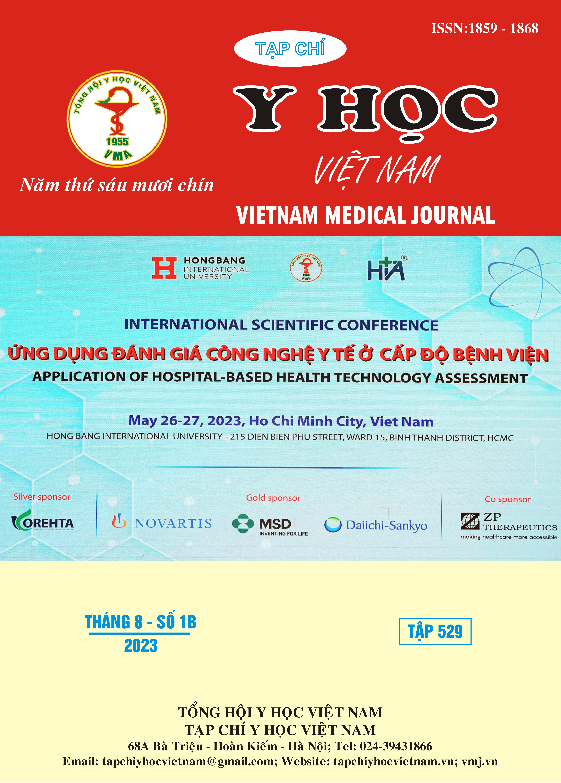ASSESSMENT OF THE RESULTS OF TRANSFORMATION OF QUARTER BRANDS IN PATIENTS WITH STENT-GRAFT AREA THORACIC AORTA
Main Article Content
Abstract
Background: In order to obtain a suitable lowering area before placing a stent graft in endovascular intervention for the treatment of aortic arch disease, in some cases, surgical transposition of the arterial branches of the aortic arch is required. However, the results of this technique to date have not been uniform. Objectives: To evaluate the short-term results of transposition of the aortic arch branches on patients with thoracic aortic stent-graft placement. Methods: A retrospective descriptive series. Results: There were 21 cases of thoracic aortic aneurysm (70%) and 9 cases of aortic dissection (30%). The average surgical time was 151 ± 34.2 minutes; the average blood loss was 157 ± 43.6 ml, and the average number of days after surgery was 6.83 ± 3.7 days. Conclusion: Transposition of branches above the aortic arch on patients with thoracic aortic stent graft was performed safely and effectively.
Article Details
References
2. A. M. Ganapathi, B. R. Englum, M. A. Schechter, et al. (2014), "Role of cardiac evaluation before thoracic endovascular aortic repair", J Vasc Surg, 60 (5), pp. 1196-1203.
3. R. R. Gopaldas, T. K. Dao, S. A. LeMaire, et al. (2011), "Endovascular versus open repair of ruptured descending thoracic aortic aneurysms: a nationwide risk-adjusted study of 923 patients", J Thorac Cardiovasc Surg, 142 (5), pp. 1010-8.
4. L. F. Hiratzka, G. L. Bakris, J. A. Beckman, et al. (2010), "2010 ACCF/AHA/AATS/ACR/ASA/SCA/SCAI/SIR/STS/SVM guidelines for the diagnosis and management of patients with Thoracic Aortic Disease: a report of the American College of Cardiology Foundation/American Heart Association Task Force on Practice Guidelines, American Association for Thoracic Surgery, American College of Radiology, American Stroke Association, Society of Cardiovascular Anesthesiologists, Society for Cardiovascular Angiography and Interventions, Society of Interventional Radiology, Society of Thoracic Surgeons, and Society for Vascular Medicine", Circulation, 121 (13), pp. e266-369.
5. W. Hogendoorn, F. J. Schlosser, B. E. Muhs, et al. (2014), "Surgical and anesthetic considerations for the endovascular treatment of ruptured descending thoracic aortic aneurysms", Curr Opin Anaesthesiol, 27 (1), pp. 12-20.
6. D. Janczak, A. Ziomek, J. Kobecki, et al. (2019), "Neurological complications after thoracic endovascular aortic repair. Does the left subclavian artery coverage without revascularization increase the risk of neurological complications in patients after thoracic endovascular aortic repair?", J Cardiothorac Surg, 14 (1), pp. 5.
7. M. K. Rose, B. J. Pearce, T. C. Matthews, et al. (2015), "Outcomes after celiac artery coverage during thoracic endovascular aortic aneurysm repair", J Vasc Surg, 62 (1), pp. 36-42.
8. T. G. Walker (2009), "Mesenteric vasculature and collateral pathways", Semin Intervent Radiol, 26 (3), pp. 167-74.
9. T. K. M. Wang, M. Y. Desai (2020), "Thoracic aortic aneurysm: Optimal surveillance and treatment", Cleve Clin J Med, 87 (9), pp. 557-568.
10. M. F. Fillinger, R. K. Greenberg, J. F. McKinsey, et al. (2010), "Reporting standards for thoracic endovascular aortic repair (TEVAR)", J Vasc Surg, 52 (4), pp. 1022-33, 1033 e15.


